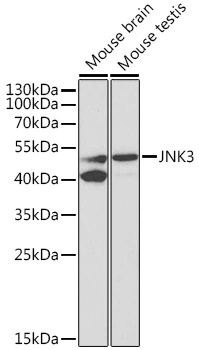anti-SAPK / JNK phospho (Thr183 (221) / Tyr185 (223)) antibody
ARG51807
ApplicationsImmunoFluorescence, Western Blot, ImmunoCytoChemistry
Product group Antibodies
ReactivityHuman
TargetMAPK10
Overview
- SupplierArigo Biolaboratories
- Product Nameanti-SAPK / JNK phospho (Thr183 (221) / Tyr185 (223)) antibody
- Delivery Days Customer23
- ApplicationsImmunoFluorescence, Western Blot, ImmunoCytoChemistry
- CertificationResearch Use Only
- ClonalityPolyclonal
- Concentration1 mg/ml
- ConjugateUnconjugated
- Gene ID5602
- Target nameMAPK10
- Target descriptionmitogen-activated protein kinase 10
- Target synonymsJNK3, JNK3A, PRKM10, SAPK1b, p493F12, p54bSAPK, mitogen-activated protein kinase 10, JNK3 alpha protein kinase, MAP kinase 10, MAP kinase p49 3F12, c-Jun N-terminal kinase 3, stress activated protein kinase beta, stress-activated protein kinase 1b, stress-activated protein kinase JNK3
- HostRabbit
- IsotypeIgG
- Scientific DescriptionResponds to activation by environmental stress and pro-inflammatory cytokines by phosphorylating a number of transcription factors, primarily components of AP-1 such as JUN, JDP2 and ATF2 and thus regulates AP-1 transcriptional activity. In T-cells, JNK1 and JNK2 are required for polarized differentiation of T-helper cells into Th1 cells By similarity. Phosphorylates heat shock factor protein 4 (HSF4). /Responds to activation by environmental stress and pro-inflammatory cytokines by phosphorylating a number of transcription factors, primarily components of AP-1 such as c-Jun and ATF2 and thus regulates AP-1 transcriptional activity. In T-cells, JNK1 and JNK2 are required for polarized differentiation of T-helper cells into Th1 cells. JNK2 isoforms display different binding patterns: alpha-1 and alpha-2 preferentially bind to c-Jun, whereas beta-1 and beta-2 bind to ATF2. However, there is no correlation between binding and phosphorylation, which is achieved at about the same efficiency by all isoforms. JUNB is not a substrate for JNK2 alpha-2, and JUND binds only weakly to it. Responds to activation by environmental stress and pro-inflammatory cytokines by phosphorylating a number of transcription factors, primarily components of AP-1 such as c-Jun and ATF2 and thus regulates AP-1 transcriptional activity. Required for stress-induced neuronal apoptosis and the pathogenesis of glutamate excitotoxicity
- ReactivityHuman
- Storage Instruction-20°C
- UNSPSC12352203






